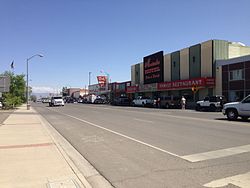Battle Mountain, Nevada
| Battle Mountain, Nevada | |
|---|---|
| CDP | |

Front Street in downtown Battle Mountain
|
|
 Location of Battle Mountain, Nevada |
|
| Coordinates: 40°38′22″N 116°56′14″W / 40.63944°N 116.93722°W | |
| Country | United States |
| State | Nevada |
| County | Lander |
| Government | |
| • Senate | Harry Johnson (R) |
| • Assembly | John Marvel (R) |
| • U.S. Congress | Open Seat |
| Area | |
| • Total | 3.6 sq mi (9.2 km2) |
| • Land | 3.6 sq mi (9.2 km2) |
| • Water | 0 sq mi (0 km2) |
| Elevation | 4,511 ft (1,375 m) |
| Population (2010) | |
| • Total | 3,635 |
| • Density | 1,023/sq mi (395.1/km2) |
| Time zone | Pacific (PST) (UTC-8) |
| • Summer (DST) | PDT (UTC-7) |
| ZIP code | 89820 |
| Area code(s) | 775 |
| FIPS code | 32-04900 |
| GNIS feature ID | 0838652 |
| Reference no. | 95 |
Battle Mountain is a census-designated place (CDP) in Lander County, Nevada, United States. The population was 3,635 at the 2010 census. Though it has no legal status as a municipality, it still functions as the county seat of Lander County. Its primary economic base is gold mining and to a lesser extent, legalized gaming.
The town is located on Interstate 80 between Winnemucca and Elko.
The Battle Mountain area was home to the Northern Paiute and Shoshone peoples. The area was noted by fur trappers in the 1820s and '30s. It served as a waypoint for westward-bound travel on the Emigrant Trail along the Humboldt River by 1845. According to local legends the name stems from confrontations between Native Americans and early settlers during the 1850s and '60s.
When copper ore was discovered in 1866 and mining began, the Central Pacific Railroad started a station to support the mining activity. In 1870 the railroad moved the Argenta station to Battle Mountain and established a townsite to serve the Battle Mountain copper and gold mining district.
In 1874, the Nevada Legislature overrode the governor's veto and approved a railroad from Austin to Battle Mountain. The Nevada Central Railroad from Battle Mountain to Austin was completed in 1880. The rail line was constructed to connect the silver mines around Austin to the Central Pacific line at Battle Mountain. The rail line served the Austin area until it was abandoned in 1938.
...
Wikipedia
